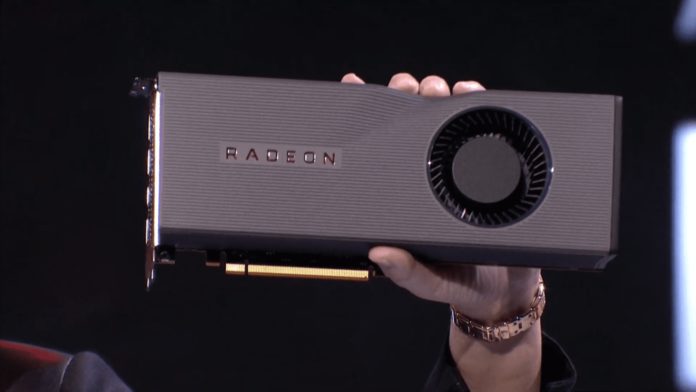AMD officially announced the 7nm Navi GPUs last night, namely the Radeon RX 5700 and the RX 5700 XT slated to go up against NVIDIA’s RTX 2060 and 2070, respectively. These GPUs are the first to feature AMD’s RDNA GPU architecture, set to succeed GCN (at least in the gaming space).
RX 5700 XT Priced @ $499US: Up to 20% Faster than the NVIDIA GeForce RTX 2070

Looking at AMD’s first party benchmarks, this seems like the same scenario as the RX 580 and GTX 1060, where the latter would win in a few select cases but be slower in all the rest. The Radeon RX 5700 XT is faster across all the benchmarks, except in Civ 6 and NVIDIA’s sponsored, Shadow of the Tomb Raider. The delta is surprisingly large in Battlefield V and Metro Exodus, considering that they are the flagship RTX titles with ray-tracing and DLSS support. In the rest of the games, including The Witcher 3, Wildlands, Assassins’ Creed Odyssey, the gains are within the margin of error.
However, at the same time, the RX 5700 XT is $20 more expensive than the 2070 and lacks H/W level ray-tracing support or any kind of special sauce like DLSS. But, if the card does prove to be notably faster than its RTX competitor in the majority (third-party benchmarks), then it’ll be a worthy addition to the upper mid-range market.

As for the specs, it’s as per the leaks had predicted. We are looking at 40 Compute Units (CUs) or 40×64=2560 Steaming processors, paired via a 256-bit wide bus to 8GB of GDDR6 RAM. The clocks are three-fold, base, gaming and boost. The base is the speed the card will run at in all 3D applications while under light load, and the boost is the maximum peak clock without overclocking.
RX 5700 Priced @ $379US: Up to 20% Faster than the NVIDIA GeForce RTX 2060

The Radeon RX 5700 packs the same GPU as its XT counterpart, except with a lower shader count and toned down core clocks. It has 36 CUs or 36×64=2304 shaders paired with the same 8GB memory via a 256-bit bus. The clocks are slightly tamer, with a base and boost of 1465 and 1724MHz, respectively. This translates into 7.95 TFLOPs of FP32 performance, slightly lower than the RX 5700 XT’s 9.75.

The benchmarks more or less paint the same picture as the other comparison. However, the RX 5700 is faster than the RTX 2060 in all the tested games, with a maximum lead in Battlefield V and Forza Horizon 4. It’s a bit glaring that Forza is absent from the other chart, probably because the RTX 2070 was faster there. No surprise, considering that these are first-party benchmarks, and all the more reason to take them with a grain of salt.
Price-wise the RX 5700 will cost $20 more than the RTX 2060. Not bad, considering that it’s a tad-bit faster. It’ll be interesting to see if NVIDIA’s Super cards are actually real and if so, how they measure up against the RX 5700 lineup. If they cost the same as their non-Super counterparts, then AMD will definitely have to do something about the pricing here.
Unfortunately, it seems like the Navi GPUs cards won’t be supporting ray-tracing on
Read more:
AMD Ryzen 9 3950X Becomes the Fastest 16-Core CPU, Beating the $1,900 Intel Core i9-9960X


